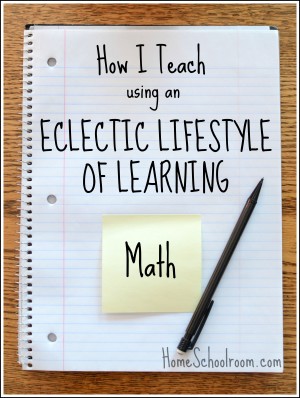How I Teach Math Using an Eclectic Lifestyle of Learning

It’s time to talk numbers in the “How I Teach” series. Don’t worry, this shouldn’t take me quite as long as yesterday’s post on how I teach language arts! My approach to teaching homeschool math is quite simple, but still eclectic. The primary instruction comes in the form of a formal curriculum, but I round it out with what most people call “living math.”
Our Math Curriculum: Teaching Textbooks
We switched to Teaching Textbooks in our second year, and though no curriculum is perfect I’m very pleased. My eleven year old daughter works independently on Math 6, but I have her show me any questions she got wrong so I can spot problem areas. Not only does Teaching Textbooks save me having to grade math problems, but it gives my daughter immediate feedback on incorrect answers. My eight year old son is working through Math 3 (the earliest level available). Because his understanding of mathematical concepts is ahead of his reading skills I find it more efficient to sit and work through the lessons with him. With him I also usually break it up and do the lecture and practice one day, the problems the next.
Memorize Math Facts
I understand the importance of having the basic math facts solidly memorized. I mean, who can learn higher level operations if they have to think about what the answer to 6+7 or 3×8 is? I also, however, detest working with my children with flashcards. Xtramath.org is a free website providing timed work on math facts. It frees me up to work on other things, able to rest comfortably that when my children receive a mastery score from Xtramath they will have their facts firmly in memory.
Living Math
So what is living math? I would describe it as working with numbers in connection with real life. I’ll list some of the general ways we play with numbers, and you can visit my Homeschool Math Pinterest board for specific ideas.
- Life of Fred: My kids love the hilarious story component of the Fred books. We’ve used some of the Elementary books and my daughter is working through Life Of Fred Fractions. Though designed as a curriculum we use them as a supplement.
- Bedtime Math: This is a super easy way to incorporate a little math problem solving. The theory is that we read stories to kids before bed, why not work math problems, too? Every day on the Bedtime Math website you’ll find a story with related math questions at three different age levels. I usually do the problems with my kids during our “learning lunch.”
- Hands-On Math: We might play store or practice Tally Marks. Whatever the concept we try to work with it with our hands. And it doesn’t have to be a game or something orchestrated just to teach the concept: try making things! There are so many options here: baking, sewing, building with wood… It’s real life math manipulatives, and they’re motivated by the end product.
- Reading about Math: That’s right, my love affair with learning through books continues with math! You’ll find great titles to get you started from Cindy West of Our Journey Westward for elementary and even middle school students!
That’s my homeschool math instruction in a nutshell. Come back tomorrow for the scoop on SCIENCE!
The “How I Teach” Series:
 Hi, I'm Heidi and I homeschool my two sweet kids. I want them to know that learning is an exciting lifelong adventure! We love great books, unit studies, notebooking, lapbooking, and hands-on learning.
Hi, I'm Heidi and I homeschool my two sweet kids. I want them to know that learning is an exciting lifelong adventure! We love great books, unit studies, notebooking, lapbooking, and hands-on learning.



